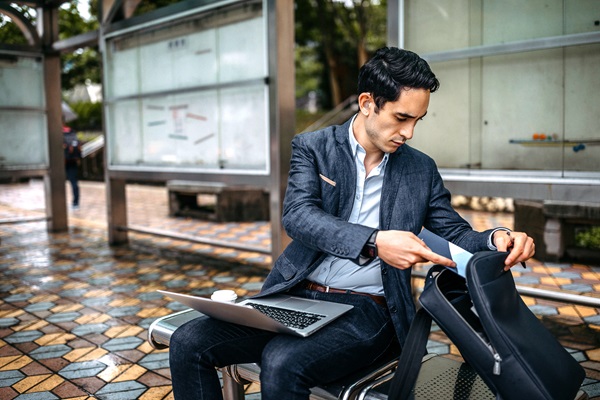In the Traveler Wellness episode of the Connections podcast, co-hosts Chad Lemon, digital strategist, and Miriam Moscovici, vice president, Partnerships and Intelligence, dive into the critical topic of traveler wellness in business travel. Joined by Amélie Losanes, a managing consultant with Advito, they explore how companies can prioritize employee well-being while balancing the needs of their travel programs. The message: Traveler wellness isn’t just a buzzword for travel teams. It’s a significant aspect of business strategy.



Helping business travelers perform at their best
Wellness in business travel goes beyond ensuring basic comfort. It’s about enabling employees to perform at their best while reducing stress, preventing burnout, and aligning travel policies with broader organizational goals, such as ESG (Environmental, Social, and Governance) priorities. Frequent travelers, often dubbed “road warriors,” are especially prone to wellness challenges due to hectic schedules and extended time away from home.
Key takeaways:
- Defining traveler wellness: Amélie explains that wellness starts with purpose-driven travel. Employees need clarity about why they’re traveling and what value the trip brings. This focus reduces unnecessary stress and improves satisfaction.
- Measuring wellness: While it’s difficult to quantify personal health, travel managers can analyze KPIs like trip frequency, cabin class, travel times, and hotel quality to assess wellness impacts. Tools like Advito’s wellness dashboard provide actionable insights by scoring trips based on risk factors such as jet lag, long-haul flights, and environmental conditions.
- Balancing act: The conversation touches on the challenge of balancing traveler needs with corporate goals, such as cost reduction or sustainability. For instance, while business-class flights might boost traveler comfort, they come with a higher environmental footprint. Similarly, flexible policies can improve employee satisfaction but require careful trade-offs.
- The role of suppliers: Suppliers like hotels and airlines play a significant role in enhancing traveler wellness. Innovations such as fitness-friendly accommodations, wellness zones on aircraft, and eco-conscious amenities contribute positively to the travel experience.
- Communication and DE&I: Effective communication is key to traveler engagement. Employees should be informed about their options, from booking tools to resources for accommodations. Diversity, equity, and inclusion (DE&I) are also crucial – policies must address the unique needs of diverse travelers to ensure safety and accessibility.
- The future of business travel: Amélie stressed the importance of evaluating the necessity of each trip. A purpose-driven approach not only improves wellness but aligns with sustainability and cost-efficiency goals.
Transcript
Introduction: Welcome to Connections with BCD Travel, an ongoing conversation about the modern-day travel program, the impact of technology, and how travel buyers can take control and drive change. What are we waiting for? Let’s start connecting.
Chad Lemon: Welcome back to Connections everyone. I’m Chad Lemon.
Miriam Moscovici: And I’m Miriam Moscovici. Thanks for tuning in.
Chad Lemon: Miriam, usually we kick off our episodes with a segment that I like to call the Quick 60 in Business Travel, where I ask you a question about something and you give me a quick 60-second answer.
Miriam Moscovici: Yeah. What do you got for me today?
Chad Lemon: Well, you’re out of the hot seat because we have a new feature on the podcast and I want to tell you and all of our listeners about it.
Miriam Moscovici: All right, let’s hear it.
Chad Lemon: So if you’re listening to this episode on one of the major podcasting platforms like Apple Podcasts, Spotify, something like that, there is a new link you can click while listening to an episode that allows the listener to send us a text message. And I know you love hearing from people.
Miriam Moscovici: That’s great. I love hearing from people. So how does that work?
Chad Lemon: Yeah. So if you’re on one of those major podcast platforms, like I said, you just have to click into the actual episode, the details where you would get the write up of it.
Miriam Moscovici: Okay.
Chad Lemon: And when you do, you’ll see a link that says, “send us a text message.” And if you click that link, you can send us feedback or a comment or whatever you want, and we’ll get it in our email inbox. It’s quick and easy. It doesn’t show us your name or your phone number or email or anything like that, just however you want to talk to us and connect with us.
Miriam Moscovici: I love it.
Chad Lemon: Yeah.
Miriam Moscovici: That’s a really easy way for folks to send us messages, maybe even give us some responses to the best shopping and airports around the world, or the various questions we ask on this podcast.
Chad Lemon: Yeah.
Miriam Moscovici: I love it. Can’t wait to hear from people.
Chad Lemon: Yeah, me too. So if you’re listening, click the link, send us a message. Even if you just want to say hi, we will say hi back to you. Okay. On today’s episode, we are discussing traveler wellness, always important, and how different business travel programs are tackling the issue.
Miriam Moscovici: And our guest, Amélie Losanes, managing consultant with Advito, is here to discuss not only how we traditionally think of traveler wellness, but also offer advice on how to make wellness sustainable for all involved.
Chad Lemon: Welcome to the show, Amélie, always great to see you again. Now, when we talk about traveler wellness as it relates to business travel, what are we talking about? What does that actually mean?
Amélie Losanes: Yeah, and thanks for having me on this podcast. So wellness, when it relates to business travel is really about ensuring that the employees that are traveling on behalf of your business are comfortable doing so, and that are also able to do the job that they were sent out to do. So in general, some things to look out for, for instance, very basic technical question: where is the traveler going? When is the traveler going and how? So there are a whole host of KPIs that we can look into. But first, for me, what’s really important to look into is “what is the value that the trip is delivering?” So that relates actually directly into wellness because you want to ensure that the traveler isn’t going to have stress. The traveler needs to prepare, and the traveler also wants to understand the outcome of the trip. And that’s why it’s so important to have a purpose of trip. And for the traveler to understand is it for professional development, business with the client, an internal meeting, speaking engagements and so on.
Miriam Moscovici: Amélie, is traveler wellness really an issue? Why should our listeners care about this?
Amélie Losanes: So yes, the short answer is yes. It is really an issue and here is why. So first off, it really falls under the ESG strategy of a company. So S stands for social, so that’s the social pillar. That’s your people, the people within your organization, but also all the people that your business interacts with or impacts. And as you probably know, companies have a duty of care towards their employees and also again, the people that they interact with. And that can be several things, can be the health, the safety, but also the wellbeing or the wellness of the employee. So again, it’s that larger sustainability duty of care strategy that we need to keep in mind when we talk about wellness. And also as part of a broader strategy that’s not necessarily related to sustainability, it’s the fact that travel can be seen as a benefit, but also as a chore. So we need, as people within the business need to understand how do our travelers feel about travel. And the travel policy can be a very powerful tool for the employee satisfaction, talent attraction, talent retention.
And the last thing that is very important and why it can be an issue within a company is those road warriors, right? It’s those people that travel a lot, that they’re always on the road. Those people may be prone to burnout, right? Because they travel constantly. Sometimes they might be more on the road than at home in a given month. And so we want to ensure that those travelers are comfortable when they travel.
Miriam Moscovici: I’ve always believed that a healthy journey leads to a successful destination. So how can we measure and manage travelers’ physical and mental wellbeing?
Amélie Losanes: So it’s very hard to measure the personal health of somebody, an employee and so on. But there are definitely KPIs that can point to how travelers are faring through how trips are booked and how comfortable those trips or those booked trips may be. So some of the things that we can look into, for instance, is the share of long-haul flights and the jet lag factor. Do you have a lot of travelers that are flying long haul international flights? How often do they fly in economy? Do they fly in business? Do they fly at night? Do they fly during the day? How frequent do those people travel? Is it the same traveler going back and forth between the same two cities? Why? So all those types of questions need to be asked. And you also have to think about the different modes of transportation that are available to the traveler. Is the traveler going to drive, to fly, take the train? There is also the productivity that comes in mind, the rest time, what is the total time door to door?
So all those factors need to really be looked into and taken into consideration. And that will give you a little bit of a picture of how effective your travel program is from a wellness standpoint.
Miriam Moscovici: And does hotel figure into this as well?
Amélie Losanes: Yes, of course, hotel as well. The question here could be where are the travelers staying? Are they staying in luxurious hotel? Are there amenities there? Or maybe they’re staying more in economy or middle scale. So yes, those types of things also need to be considered.
Chad Lemon: I agree, I do think traveler wellness is very important for a variety of reasons, including retention, new talent recruitment. But often everyone is expected to perform at their best, but we don’t all travel the same.
Miriam Moscovici: Right.
Chad Lemon: A company’s travel policy, for example, might allow one person or one level of an employee to travel in a higher class of service or more comfortable rental car, something along those lines. Amélie, do you have any insight on how we help solve that?
Amélie Losanes: So I think it’s a tricky question because the travel policy is the travel policy and sometimes travel policy can be rigid. But what I would say is that a lot of travel policies do allow for some types of flexibility. And so it’s very important that you know who you are as a traveler and what’s important to you. So for instance, if you are booking a hotel, is it location that matters to you? Do you want to be in a cool location, for instance, inside the city center? Or do you want to be close to where the meeting is happening? Or maybe it’s sustainability, you want to stay in a eco-friendly hotel, or maybe you want specific amenities, you want a gym or a pool, right? So as a traveler, you have to take this active part in deciding how you want to travel.
Also, an idea could be to travel a day before or the day off, right? Depending on how you operate on whether you want to sleep at home or are you okay with waking up early and taking a flight in the morning and so on. So there are all those types of items that you can think about and really based on who you are as a person, you can make those decisions. And again, policy may be rigid, but generally, there’s always a little bit of a flexibility there to help you increase your level of wellness based on what you need. And the one thing I would say that has for me changed things is asking myself that question again, going back to the first thing I said when we started talking is whether the trip is necessary. Having those conversations with my managers now, it’s something that I never did in the past. And personally I travel less, but when I do, it’s always worth my time and that increases my satisfaction. And so I travel with comfort when I do. And I think that’s really a game changer in my opinion.
Miriam Moscovici: Well, speaking of policy, so many factors go into a company’s travel policy that directly ties to this idea of traveler wellness. So can there ever be a balance between what the company wants and their goals and what the travelers say that they want and need when they’re traveling?
Amélie Losanes: I think here it’s more of a balancing act. So there are recommendations that can be made, to allow different needs to coexist. But again, it comes to this working with the policy and knowing yourself. So kind of going back to that first question is those two things. Now, I’m going to answer your questions kind of addressing more traveler managers here. I think for travel managers to make sure that wellness is part of the picture, I think it’s important to work with, for instance, good airlines or hotels that bring you the rates that you need but also have those wellness factors. So going to that hotel section. So for instance, you can be working with upper upscale and upscale hotels instead of maybe luxury if cost is really important within the travel policy, because those types of hotels also provide a good level of comfort. So you’re not really compromising on comfort for your travelers, but you are effectively reducing cost to some extent. So again, a balancing act depending on what the priorities are.
And another one that I think is pretty important is allowing travelers, especially, in areas where it’s available to choose rail when they can, again, because that’s productivity, but also wellness.
Chad Lemon: I have a two-part question for you. First, you’ve mentioned duty of care multiple times so far. So I want to know how you view wellness and the concept of traveler wellness playing into a company’s duty of care policy. But also knowing how Advito works and the Engage Practice works, how do you see communications playing into traveler wellness?
Amélie Losanes: Yes. So when we talk about duty of care generally it’s about knowing where your travelers are and when they’re traveling. So that’s generally what people think about when they think about duty of care. But there are different aspects that we can also take into consideration. So it’s that physical and mental health of your travelers. So again, going back to that burnout or potentially too much travel. But then there is also the DE&I component. So diversity, equity and inclusion components, because that plays a very important role into making travel, for instance, more accessible but also safe and also enjoyable for the employee. So it’s important that travel managers understand their travelers backgrounds. The gender, is it a person of color? Is it a person with a disability? Is it a person with a different sexual orientation? All those things actually really matter to make those travelers feel safe and able to travel when they have to. So that’s again, that duty of care around wellness.
And then your second question was relating more to communications and engaging with travelers, and I believe that’s really, really crucial. If we don’t engage employees, all your efforts, so creating a travel and expense policy, for instance, it might not pay off, it might not be as effective because your travelers just are not aware of what options exist. So here the communications, super important in my opinion. It’s educating your travelers on their booking option, online booking tools, who to talk to if they have concerns. For instance, if I’m a person with a disability and I’m asked to go on a trip, I want to be able to reach out to someone and ask them how they can make accommodations for my needs. And so if there is no open channel of communications with the employees, the traveler is not going to know who to reach out to. So I think that’s really, really, really important. It’s also a way to bring travel within the company culture. Yeah. So I think it’s very important.
Miriam Moscovici: Amélie, I want to talk a little bit about trade-offs though. And by that I mean that a company might need to sacrifice or trade something off if they’re really serious about increasing traveler wellness and satisfaction in their workforce. How do you feel about that?
Amélie Losanes: Well, I think first what travel managers need to do is really listening to their travelers. So that kind of goes back into this communication, having a two-way street with talking with travelers and listening to them. Because you might actually be surprised to understand, or you might actually be surprised to see whether your travelers want to travel or not and why. So that’s again part of this employee engagement and those understanding that travelers are segmented into different groups. Again, the road warriors, the frequent travelers, occasional travelers. So I just wanted to open by saying that. But then in terms of trade-offs, I think here again, we need to be careful. It’s less about sacrificing, it’s rather about prioritizing based on the goal of the company. So again, every business is different and we need to keep that into mind.
So for instance, it could be wellness over cost. For instance, if you have a company that’s really focused on costs, so there it might affect the business class allowance or for instance, the first class in rail. So that’s something that travel managers might have to think about. Another area that could be deprioritized when it comes to wellness is the environmental sustainability. So here I’m really talking about the CO2 footprints specifically for long distance travel. Again, going back to that business class, it’s from a sustainability standpoint, business class pollutes more, but from a wellness standpoint, it’s a better experience for the traveler.
And then the last piece is really the company culture that needs to potentially evolve because there is a new working class coming and they’re also setting the pace and they have different needs and values than other employees in the company. So I think that’s also important that companies are open and willing to listen to those new travelers as well.
Chad Lemon: On the Connections Podcast, we typically talk about how technology is making business travel better. And I’ve heard that Advito has pioneered a dashboard that helps travel managers measure their company’s traveler wellness score, so to speak. What can you tell us about it?
Amélie Losanes: Yes. So we do have a wellness or wellbeing dashboard that we use for our clients. And so it goes back to those KPIs that I was mentioning throughout this podcast. So what we do is we provide every trip with a score and the score is reduced with every risk factor. So the risk factors could be the travel time. Is the traveler going to travel outside of business hours on the weekend? Are they going to a risk destination? Is there air pollution where they’re going compared to where they currently live? Cabin class, jet lag, and so on. So we look at all those risk factors. And so the trip starts at 100 points and then every time there is a risk factor involved, the score gets reduced. And so that is a dashboard that clients can go into and drill down at different levels as well.
So they can look at their regional travel, their international trips, also their traveler types, again, those road warrior, frequent travelers and so on. And thanks to that they can really look at the patterns and potentially what are the gaps that they have in their travel policy or in their travel program. And it really helps them understand how their employees travel.
To give you a concrete example, if you have a traveler that takes a direct flight, that would increase, so to say, the sustainability score compared to a red eye or a flight with a connection. So that’s how we look at things. And then on this topic, what we often do is we couple the Wellness Dashboard with the Emissions Dashboards because here we really want to make sure that the recommendations that we have can be made for the environment while travelers remain happy and comfortable, right? Because the emissions reduction should not come at the traveler’s expense. And that’s very, very important. And that’s why generally clients use both of those dashboards to make changes within their travel programs.
Chad Lemon: I recently took a trip and I stayed at an Even Hotel and I noticed they had cork flooring and fitness equipment in the room, like exercise balls and yoga mats. And I believe it’s Westin that’s famous for lending out workout gear and apparel at some of their properties with fitness bikes. And Hilton has their Five Feet to Fitness rooms. Mandarin Oriental has those new mirror workout stations, which I think was super cool.
Miriam Moscovici: Oh, yeah.
Chad Lemon: Yeah. And it just got me thinking as we were having this discussion about the role that suppliers or vendors have in traveler wellness.
Miriam Moscovici: One of my favorite things I’ve seen recently is the Wellness Zone that Qantas has revealed on their new A350.
Chad Lemon: Mm-hmm. Yeah.
Miriam Moscovici: Their Economy and Premium cabins, it’s got curated movements, large monitors, pretty remarkable on an actual aircraft.
Chad Lemon: Yeah, it’s amazing.
Amélie Losanes: Yeah. And when I travel, I love staying at hotels that are more sustainable, right? They have vegan or vegetarian foods. One of my favorite things is bike rentals after work, being able to tour the city with my bike. Or gardens on the roofs, I think that really impacts the experience of the travelers. I think that’s something that they can look into.
Chad Lemon: Okay, Amélie, last question for you. What’s the one thing you want our listeners, travel managers, to know about wellness policies and plans?
Amélie Losanes: So I’ll close with what I’ve started actually, because I think it was very relevant at the beginning, and it’s even more relevant at the end. The focus should really be about determining the value of the trip, that purpose of trip. Because it’s important to understand when to travel, if it is making sense, because then you look into wellness, but also emissions as well as time and money. And wellness ties into so much, so I think in order to really be able to tackle it, I would start with this, the value of the trip and finding a system internally to really assess when a trip should take place.
Chad Lemon: Miriam, I think that you and I have got to find a way to get on one of those flights with the workout space. I think it sounds so cool.
Miriam Moscovici: And I think if the space is big enough to do a workout, it should be big enough to set up a card table and a card game.
Chad Lemon: Yeah, let’s get it going. Just invite everyone around to join in.
Miriam Moscovici: Euchre at 40,000 feet.
Chad Lemon: I am a fan. I love it. You never know. You never know.
Miriam Moscovici: But that’s all for this episode. Listening to us on Apple Podcasts or Spotify? Send us a message using the new link in this episode description and give us your traveler wellness tips.
Conclusion: Thank you for connecting with us. BCD Travel helps companies travel smart and achieve more. We drive program adoption, cost savings, and talent retention through digital experiences that simplify business travel. Learn more about the topics you heard on this episode by visiting bcdtravel.com/podcast.



